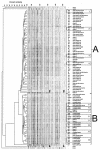Molecular epidemiology of Aspergillus fumigatus isolates recovered from water, air, and patients shows two clusters of genetically distinct strains
- PMID: 12958232
- PMCID: PMC193792
- DOI: 10.1128/JCM.41.9.4101-4106.2003
Molecular epidemiology of Aspergillus fumigatus isolates recovered from water, air, and patients shows two clusters of genetically distinct strains
Abstract
There has been an increase in data suggesting that besides air, hospital water is a potential source of transmission of filamentous fungi, and in particular Aspergillus fumigatus. Molecular characterization of environmental and clinical A. fumigatus isolates, collected prospectively during an 18-month period, was performed to establish if waterborne fungi play a role in the pathogenesis of invasive aspergillosis. Isolates recovered from water (n = 54) and air (n = 21) at various locations inside and outside the hospital and from 15 patients (n = 21) with proven, probable, or possible invasive aspergillosis were genotyped by amplified fragment length polymorphism analysis. Based on genomic fingerprints, the environmental A. fumigatus isolates could be grouped into two major clusters primarily containing isolates recovered from either air or water. The genotypic relatedness between clinical and environmental isolates suggests that patients with invasive aspergillosis can be infected by strains originating from water or from air. In addition, 12 clusters with genetically indistinguishable or highly related strains were differentiated, each containing two to three isolates. In two clusters, clinical isolates recovered from patients matched those recovered from water sources, while in another cluster the clinical isolate was indistinguishable from one cultured from air. This observation might open new perspectives in the development of infection control measures to prevent invasive aspergillosis in high-risk patients. The genetic variability found between airborne and waterborne A. fumigatus strains might prove to be a powerful tool in understanding the transmission of invasive aspergillosis and in outbreak control.
Figures

References
-
- Anaissie, E. J., R. T. Kuchar, J. H. Rex, A. Francesconi, M. Kasai, F.-M. C. Müller, M. Lozano-Chiu, R. C. Summerbell, M. C. Dignani, S. J. Chanock, and T. J. Walsh. 2001. Fusariosis associated with pathogenic Fusarium species colonization of a hospital water system: a new paradigm for the epidemiology of opportunistic mold infections. Clin. Infect. Dis. 33:1871-1878. - PubMed
-
- Anaissie, E. J., S. L. Stratton, M. C. Dignani, R. C. Summerbell, J. H. Rex, T. P. Monson, T. Spencer, M. Kasai, A. Francesconi, and T. J. Walsh. 2002. Pathogenic Aspergillus species recovered from a hospital water system: a 3-year prospective study. Clin. Infect. Dis. 34:780-789. - PubMed
-
- Anaissie, E. J., S. L. Stratton, M. C. Dignani, C.-K. Lee, T. H. Mahfouz, J. H. Rex, R. C. Summerbell, and T. J. Walsh. 2002. Cleaning patient shower facilities: a novel approach to reducing patient exposure to aerosolized Aspergillus species and other opportunistic molds. Clin. Infect. Dis. 35:86-88. - PubMed
-
- Arvanitidou, M., S. Spaia, A. Velegraki, M. Pazarloglou, D. Kanetidis, P. Pangidis, N. Askepidis, Ch. Katsinas, G. Vayonas, and V. Katsouyannopoulos. 2000. High level of recovery of fungi from water and dialysate in haemodialysis units. J. Hosp. Infect. 45:225-230. - PubMed
-
- Ascioglu, S., J. H. Rex, B. de Pauw, J. E. Bennet, J. Bille, F. Crokaert, D. W. Denning, J. P. Donnelly, J. E. Edwards, Z. Erjavec, D. Fiere, O. Lortholary, J. Maertens, J. F. Meis, T. F. Patterson, J. Ritter, D. Selleslag, P. M. Shah, D. A. Stevens, and T. J. Walsh. 2002. Defining opportunistic invasive fungal infections in immunocompromised patients with cancer and hematopoietic stem cell transplants: an international consensus. Clin. Infect. Dis. 34:7-14. - PubMed
Publication types
MeSH terms
LinkOut - more resources
Full Text Sources
Medical

